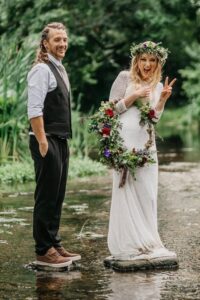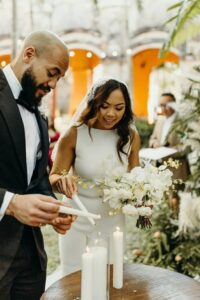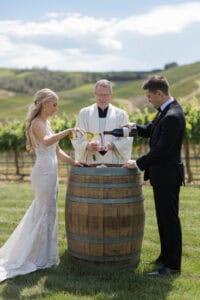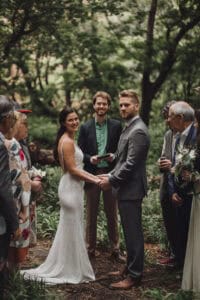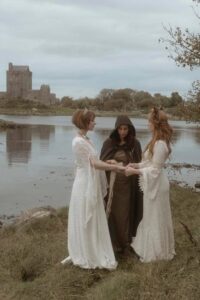Nonreligious wedding ceremonies are just as common, if not more, than religious ceremonies. Depending on where you get married and if you opt for a celebrant or officiant you have lots more options with a nonreligious ceremony.
I love that you can include some unique unity ceremony ideas to start your own traditions. You can get creative and write your own vows, include family or friends during the ceremony.
We are sharing all our favourite nonreligious wedding ceremony ideas to hopefully inspire you to create your own uniqueceremony.
Unity Ceremony Ideas for Nonreligious ceremonies
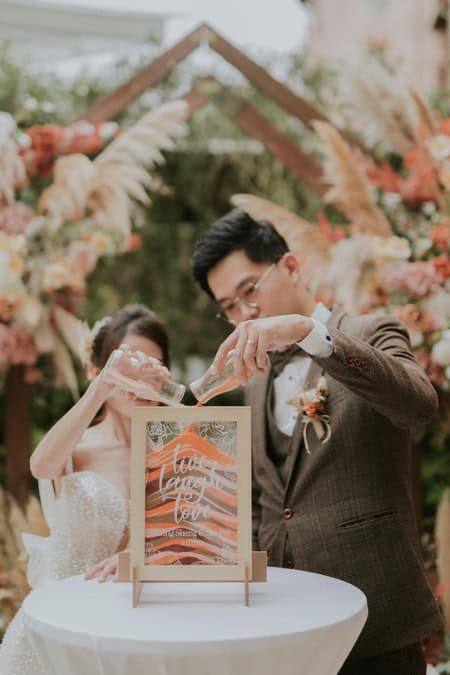
Sand Ceremony
During a sand ceremony, each partner pours a different colored sand into one clear container. Mixing the sands represents the merging of their lives. It’s visually appealing and allows for creativity in choosing sand colors that match the wedding theme or represent something meaningful to the couple.
Candle Lighting
For the candle ceremony, both partners light individual candles and then together light a central larger candle. This act symbolizes unity and the new life they are starting. It’s simple yet powerful, and it works indoors and outdoors, as long as the weather cooperates!

Tree Planting
Planting a tree can be a beautiful part of the ceremony, symbolizing growth and life. Couples often add soil from two significant locations, blending their pasts into a growing future. Plus, they get to revisit the tree over the years!
Handfasting
In a handfasting ceremony, a ribbon or cord is draped over the couple’s hands as a symbol of their union. It’s a beautiful nod to tradition and can be tailored with different colors or materials to signify various personal meanings.
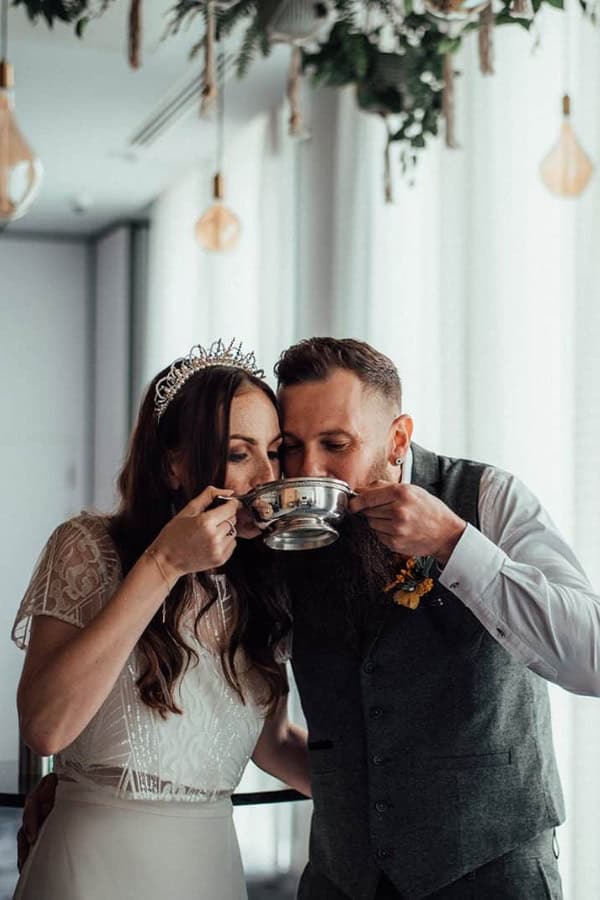
Quaich Ceremony
The Quaich, or “loving cup,” is a two-handled Scottish cup. The couple drinks whisky or another beverage from it, symbolizing trust, sharing, and respect. It’s a lovely tradition for celebrating heritage or just adding a touch of historical romance.
Painted Canvas
Couples can paint a canvas during their ceremony, each adding their own colors and strokes. This can be an abstract representation of their union, and it’s especially fun if they’re into art. The finished piece makes a great keepsake for their home.
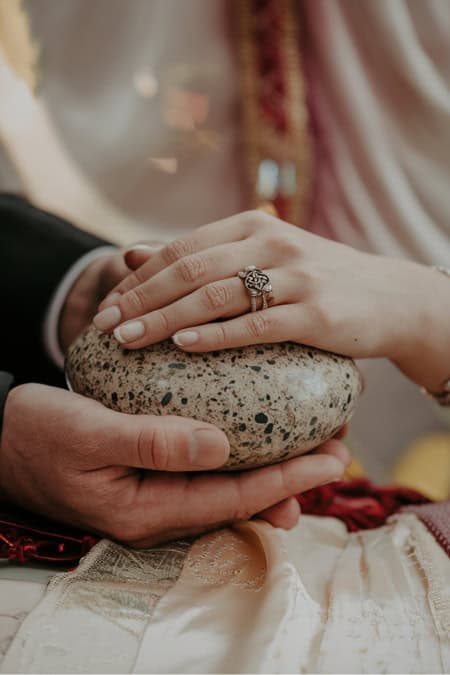
Stone Oathing
Here, guests and the couple place stones with written wishes or blessings in a bowl or another container. It can be deeply meaningful, giving everyone a role in the ceremony and creating a collective spirit of support.
Jumping the Broom
This tradition involves the couple jumping over a broom laid on the ground, symbolizing a new beginning and sweeping away the old. It’s a fun and lively moment that often brings smiles and cheers.
Wine Box Ceremony
A wine box ceremony involves the couple sealing a box containing a bottle of wine and love letters to each other, which they intend to open on a future anniversary. This acts as a time capsule and a reminder of their wedding day and the promises they made.
Unique nonreligious ideas to make your ceremony personal
Write Your Own Vows
Writing personal vows is perhaps one of the most heartfelt aspects of a nonreligious ceremony. It gives couples a chance to express their commitments in their own words, making the moment truly intimate and special.
These elements can mix and match perfectly to reflect the couple’s personalities and relationship, making their big day memorable and uniquely theirs.
Musical Selections
Couples can choose songs that are significant to them, regardless of traditional wedding music norms. This could be anything from a favorite rock song for walking down the aisle to a pop song for the recessional.
Personalized Readings
Instead of traditional religious texts, couples might select readings from literature, movies, or even personal letters or poems that resonate with their relationship. These readings can be performed by close friends or family members, adding another layer of intimacy.
Symbolic Gifts or Exchanges
Apart from or in addition to rings, couples might exchange other meaningful items during the ceremony—like family heirlooms, gifts they gave each other when they first met, or new items that symbolize their future together.
Cultural Elements
Incorporating cultural traditions from both partners’ backgrounds is a great way to honor heritage while keeping the ceremony secular. For example, incorporating a tea ceremony, traditional attire, or dances.
Celebrant-Led Ceremony
Having a celebrant means the ceremony will be tailored to the couple’s personal story and values, making it incredibly personal and meaningful without religious overtones. Celebrants are great at creating a flow that reflects the couple’s unique relationship.
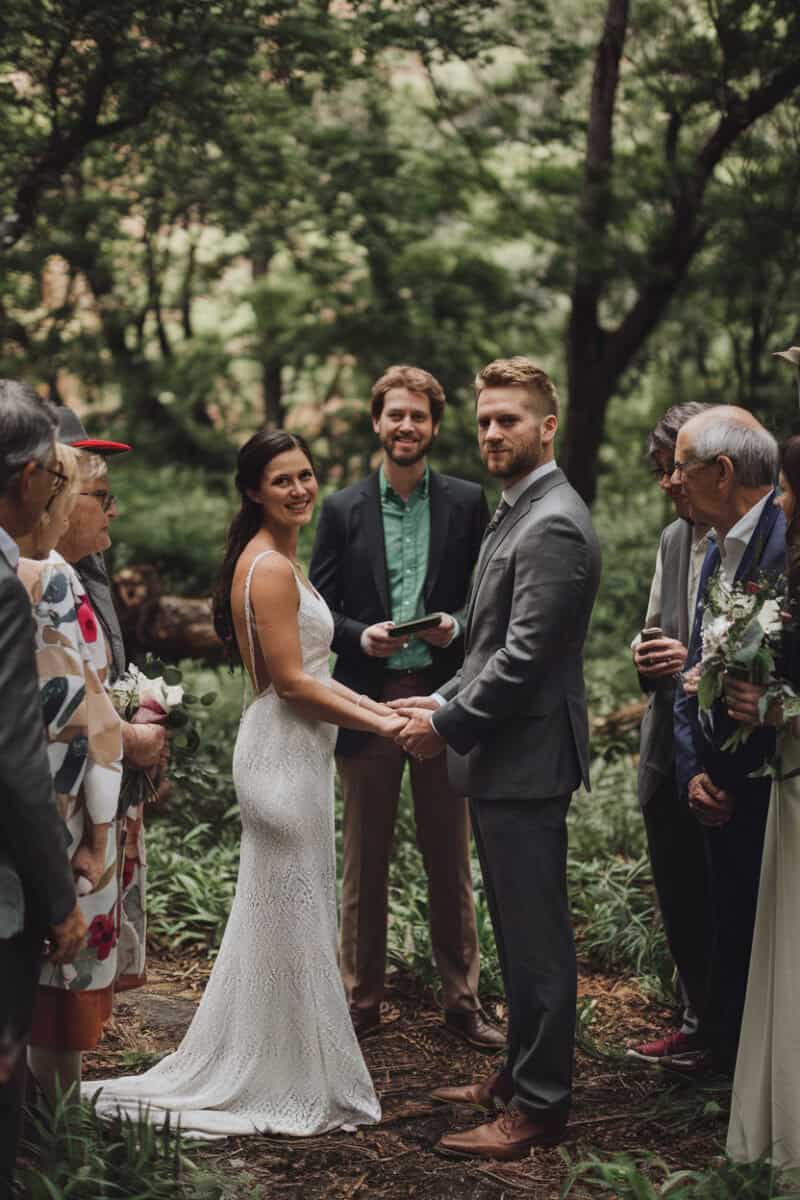
Tips for planning a nonreligous wedding ceremony
Planning a nonreligious wedding ceremony can be a wonderful opportunity to truly customize your special day to reflect your personalities and values. Here are my top tips to help couples make their nonreligious ceremony unique and memorable:
1. Reflect Your Personalities
Use the freedom of a nonreligious ceremony to highlight what makes your relationship unique. Incorporate your hobbies, interests, and passions into the ceremony, whether through music, readings, or special rituals that reflect your shared experiences.
2. Choose the Right Officiant
Select an officiant who understands your vision and is skilled at conducting nonreligious ceremonies. This could be a professional celebrant or a friend or family member who gets you both as a couple and can tell your story authentically.
3. Create a Meaningful Structure
While you aren’t bound by traditional formats, having a clear structure helps keep the ceremony flowing smoothly. Decide the order of events, from the procession to readings, vows, unity rituals, and the final pronouncement.
4. Write Your Own Vows
Personal vows are the heart of any wedding ceremony. Writing your own allows you to express your feelings and commitments to each other in your own words, making the moment truly intimate.
5. Incorporate Symbolic Rituals
Choose from various unity rituals that symbolize the coming together of your lives. Options like a sand ceremony, handfasting, or creating a time capsule can add depth and personal significance to your ceremony.
6. Involve Your Guests
Make your guests feel involved by incorporating them into the ceremony. This could be through a ring warming ceremony, where the rings are passed among guests before reaching the altar, or by inviting guests to read a line of a poem or a blessing.
7. Choose a Meaningful Location
Pick a location that is special to you, whether it’s a place where you met, a spot with a stunning view, or somewhere that reflects your interests, like a museum, park, or even your own backyard.
8. Use Nontraditional Music and Readings
Select music that resonates with you as a couple and choose readings from sources that hold special meaning, whether literature, movies, or even personal letters.
9. Plan the Decor to Reflect Your Theme
Decorate the ceremony space in a way that reflects your personal style or theme. This can include nontraditional elements like unique floral arrangements, artwork, or meaningful artifacts.
10. Keep it Intimate
If you prefer a more intimate setting, don’t feel pressured to invite everyone you know. Keeping the ceremony small can make it feel more personal and special.
These tips can help ensure that your nonreligious wedding ceremony feels as meaningful and special as any traditional wedding, celebrating your love in a way that’s uniquely yours.
More blogs you will love!
- Nonreligious Wedding Reading Ideas: Celebrate Love Your Way
- Spiritual Wedding Ideas: Meaningful Rituals for a Deeply Personal Celebration
- Unity Wedding Vow Ideas and Tips to Write Your Own
- Crafting Meaningful Nonreligious Wedding Vows with examples
- How to Write Nonreligious Wedding Ceremony Scripts: A Guide for Every Couple
- Unique Unity Ceremony Ideas you have never heard of before!
- Non Religous Wedding Ceremony Ideas
- Unity Wedding Ceremony Ideas for a Nontraditional Wedding
- Pagan Wedding Guide: Traditions, Rituals and Ceremony Ideas

